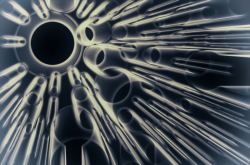Particles with a size of 10 to 100 nm are referred to as mesoscopic. Their size puts them between the quantum and “regular” worlds; this means that, in regular conditions, nanocrystals behave like regular Brownian particles, constantly in motion and colliding with each other. However, if their kinetic energy were to be lowered, along with their speed and temperature, they will enter a quantum state. Such an effect can be achieved using optical cooling.
Physicists from ITMO University have studied the optical cooling of mesoscopic articles using ytterbium ions. Ions of this element absorb photons from laser light sources and re-emit them with more energy. At the same time, they borrow some of a nanocrystal’s kinetic energy, meaning that it decreases after each collision with a photon.
“We find it hard to walk when wind is in our face, as it pushes us back. It’s the same kind of thing with nanocrystals, but with photons instead of air,” – explains Yurii Rozhdestvensky, professor at ITMO’s Department of Optical Physics and Modern Natural Science, - “If a nanocrystal is bombarded with photons, it loses all of its kinetic energy and stops. This process is what we call optical cooling”.

The scientists' set-up in use
In order for the cooling to be effective, a nanocrystal has to be exposed to photons for more than a minute while remaining in the same place. To ensure that, the scientists have constructed a special radiofrequency trap.
“A nanocrystal has an electric charge, and so in a constant electric field it will continually move towards one of the poles,” – explains Semyon Rudyi, lead author of the article, – “But the trap generates an alternating field. Its polarity changes constantly, forcing the nanocrystal to change its direction of movement. We can adjust the field’s parameters and time of switching in order to make it so that the nanocrystal remains in practically the same point in space”.
The scientists also created a radiofrequency trap that can hold a particle in place for prolonged amounts of time using little force. This gives it an advantage over other particle localization tools such as optical tweezers.
“Optical tweezers hold a particle in place with a focused laser beam,” – says Ivan Kosternoy, ITMO student and one of the trap’s creators, – “It is a somewhat expensive method and one incapable of holding a particle long enough to cool it effectively and study its properties”.
The newly-developed system allows scientists to cool a nanocrystal to a temperature of 10-8 К, which is 10 billion times less than room temperature and is also the quantum limit.
“In those conditions, a nanocrystal can enter a quantum state. It starts to behave as an atom or an ion,” – explains Tatiana Vovk, ITMO student and one of the authors, – “Such objects are very relevant to fundamental science and can help us learn more about the dynamics of quantum objects and other phenomena”.

Yurii Rozhdestvensky and Andrei Ivanov
In the future, scientists plan to study biological objects and organic molecules using radiofrequency traps.
“We want to experiment with DNA or maybe whole cells. Using optical cooling with objects like these opens up new opportunities for fundamental research into living matter. This kind of inquiry would call for new types of radiofrequency traps, which we are already working on,” – shared with us Andrei Ivanov, head of the Department of Optical Physics and Modern Natural Science.
Reference: Deep laser cooling of rare-earth-doped nanocrystals in a radio-frequency trap. S. S. Rudyi, T. A. Vovk et al. Journal of the Optical Society of America B Nov. 3, 2017.





